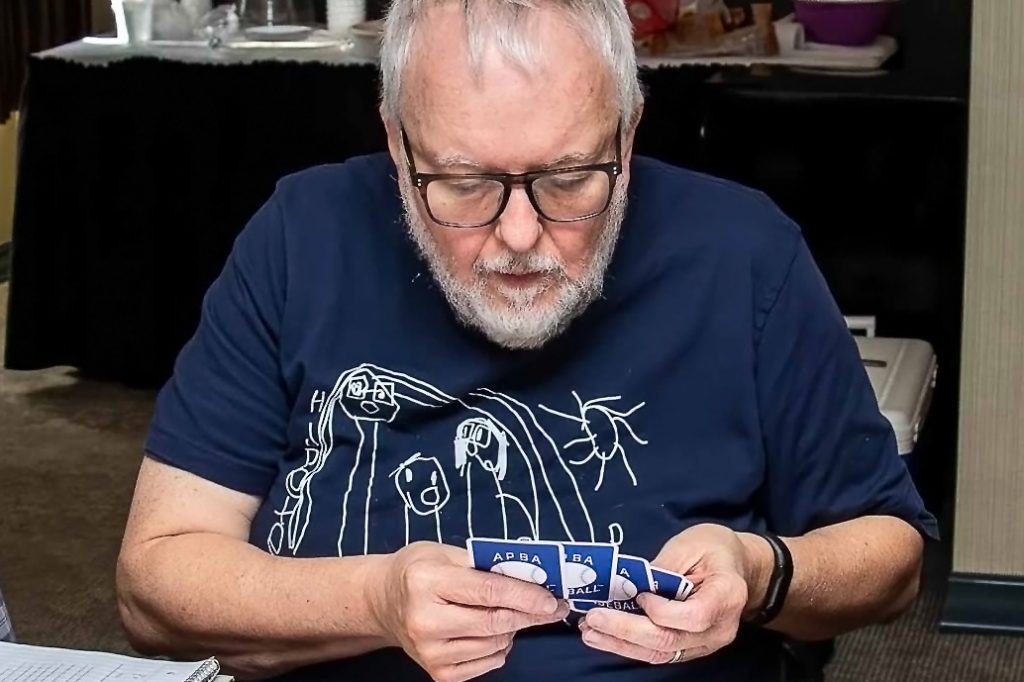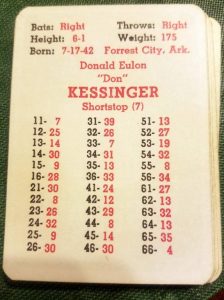An effective lineup is helpful in scoring runs in the actual game of baseball. As baseball fans, we all know the components of a high-scoring lineup. Speedy, high-OBP hitters at the top, the best hitter in the third spot, sluggers in the fourth and fifth spot and so on. Baseball Reference’s BP Bullpen has a solid tutorial on Batting orders you can review.
How we adapt that to the game of APBA depends on you. I know some who refuse to play ‘APBA-ball’ in any sense and won’t make decisions based solely on the number on the cards or charts. Instead, they make those decisions on what makes ‘baseball-sense’ even if there an advantage given to them by the game engine. Then, there are the rest of us.
Let’s look at the methods we can use to lineups in the game of APBA.
Actual lineup
If you are replaying a season or otherwise playing a stock baseball team, you can use the actual lineups played in real life. In a replay, it is possible to determine the batting order for each individual game. I do this with my oft-ignored 1966 NL replay and I’m so glad I did. For me, it’s interesting to see the changes made. I think we know intellectually that the best player at each position simply cannot play every day. Replaying actual lineups shows me that in a more tangible way.
This method obviously doesn’t leave much to creativity. The lineup is what it is. I will add that it is also not always optimal. Real life managers don’t have the advantage of hindsight that APBA managers do. I sometimes cringe at the lineups that the 1966 managers came up with wishing I could show them their players’ APBA cards.
Case in point: Cincinnati Reds Gordy Coleman primarily batted fourth for the time he played in 1966. Coleman, I guess, was good at one point in his career but his 1966 APBA card kinda stinks. Aside from being slow and 1B-2, he has two 0s.
Deron Johnson would be a better fit at first base but hey, I’m not the one who gets paid to manage.
If you are interested in finding the batting orders in most any MLB game, they can be found on Baseball Reference. For more info on how to do this, check out this article I wrote about the topic.
Creating your own lineup
If you are in a league or engaging in a project that involves drafted players that stray from stock teams, you will need to create a new lineup. Or maybe you simply want to try your hand at creating a lineup for that stock team.
What’s a good way to come up with a decent batting order? Here’s my method:
Take your starting nine players and for each one, count the number of automatic on-base numbers on their card. That will include numbers 1-7, 10-11, 14 and 42. I even place them on the table in front of me in relation to their number of on-base numbers. If you know the opposing pitcher’s grade, you can refine the process further.
Now, sometimes there will be a Babe Ruth who has the most on-base numbers. He obviously isn’t going to lead off especially if he has a 5. But still, this method gives me a good starting point for crafting a lineup.
The top of the order
Leadoff
In my opinion, the primary goal of the leadoff hitter is to get on base. A player with lots of 14s is preferable. If he has a 7, that’s good but that 7 could be a run-generator a little lower in the lineup.
It would preferable if this player was fast. Why? One big reason; if he gets on first, he will then score on a double.
Finally, it would be helpful if he has an eleven or two. Honestly, this isn’t a deal breaker for me. I would much rather he get on base. ‘You can’t steal first base’, as they say.
Second
Old school thinking has the man in the #2 spot as a strictly a contact hitter. I agree to a point. I think this hitter should also be able to coax a walk and have a fair amount of 14s. That leadoff man isn’t always getting on base.
This is my theory. As we move towards the middle of the order, the amount offense coming from the hitter should come more from his hits rather than his walks.
The middle of the order
Third
I put one of my best average hitters in the third spot especially if they have a bit of power. A card with a 55-7 and four power numbers is ideal.
We don’t want many 13s on this card since moving the runner along is the objective. It is also critical that this hitter have as few 24s as possible.
I bat Vladimir Guerrero Jr. in the third spot of my Thunderchickens’ order. If it were a perfect world, he wouldn’t be slow. In general, I don’t recommend putting any slow players in the top four spots if you can help it. As it is, Vlad is responding well by batting .363 so far this season.
Cleanup
When we get down to the cleanup spot, hopefully there is a runner (or two) on base. The goal is to get them home. The cleanup hitter should be the one with power numbers (1-6) yet still has a good batting average so a 22-8 is suspect.
Similar to the #3 spot, we should avoid players with many 24s. And while sluggers are known to strike out more, we would prefer to keep the 13s to a minimum.
Fifth, Sixth
Essentially, these spots are similar to the cleanup only with maybe less power and lower batting averages. You may relegate your power hitters with a few more 13s in these spots.
The bottom of the order
Seventh, Eighth and Ninth
Depending on the makeup of your team, put the rest of your lineup in the order of offensive value. I’m kinda picking on Chicago Cub Don Kessinger because he was on the first team I rooted for in the late 60s and early 70s. But his 1965 card is a good example of one I would bat eighth or ninth.
To his credit, he doesn’t have many 13s for a .201 hitter and could be used to bunt a runner over.
I know some managers who in the non-DH era, would bat the pitcher eighth and place a lesser leadoff-type in the ninth spot to spur the offense once the #1 batter comes up. There is some validity to this as a player who is rated fast won’t clog the base paths if he gets on.
Things to watch for
There are some aspects of the APBA baseball game that can help (or hurt) your team’s performance depending on your lineup. I’ve touched on a few already but here are a few more.
Who’s your opposing pitcher?
The grade of the pitcher you are facing will make a difference. Take this example: say you’re facing a C pitcher. If you have a hitter adorned with four 8s, he has some hits on his card! You could move him up in the batting order.
On the other side of the spectrum, we see a fair amount of hitters who only have two 8s. Time to move him down in the lineup or maybe even give him a day off.
The 5
If you have a hitter with a player result number 5 or even better two, it helps to bat someone with a high on-base chance ahead of him to take advantage of its clutch abilities.
Bat someone with a lot of 14s ahead of him and you may see a few more home runs.
The 24
I’ve alluded to this double play-inducing number already. Hopefully, your team doesn’t have many. If you do, try not to bat them in key spots like the middle of the order. Or if you are so inclined, try using the hit and run play which negates the twin killing.
To that point…
The 31
For many years, the hit and run had fallen out of favor both in baseball and in APBA. Baseball just never utilized the run game and for APBA, they made their hit and run chart a bit more restrictive and honestly, more realistic. But the game may be changing.
Even with the more restrictive hit and run charts, if you have a Luis Arraez with three 31s, it makes sense to bat him behind a player with an 11. Doing that will allow you to take advantage of the hit and run play. You at least have that option. It doesn’t hurt that you would avoid Arraez’ three 24s either.
Managing slow runners
I’ve already written an article about using the Optional Base Coaching. But if you are blessed with multiple slow runners in your lineup, it might be difficult to come up with an effective batting order.
I honestly go back and forth on this matter. All other things equal, is it better to clump your slow runners together in the order or alternate them with faster ones?
No one wants to get a rally going only to find two slow runners on first and second. Alternating them might give you a better chance to score but doing so means you are most likely batting a (S) runner higher in the order.
Summary
I admit this article is very era-dependent. What lineup strategies that work for modern baseball may not work for the 1920s or 1930s. And I have very little experience in constructing lineups for deadball teams. Maybe Scott or Rod can chime in.
Did I miss anything? Do y’all have certain methods you use when creating batting orders?







No one has ever “clogged up the bases” in the history of baseball.
More baserunners are good. Fewer baserunners are less good.
One of the most fun things to me is experimenting with different lineups in my BATS 2 league.